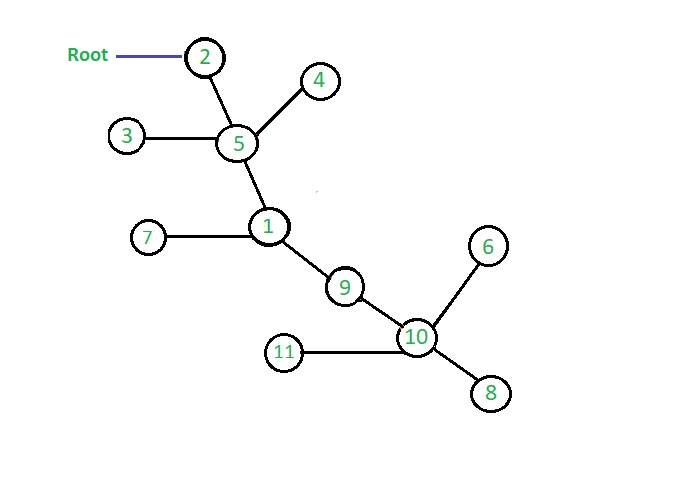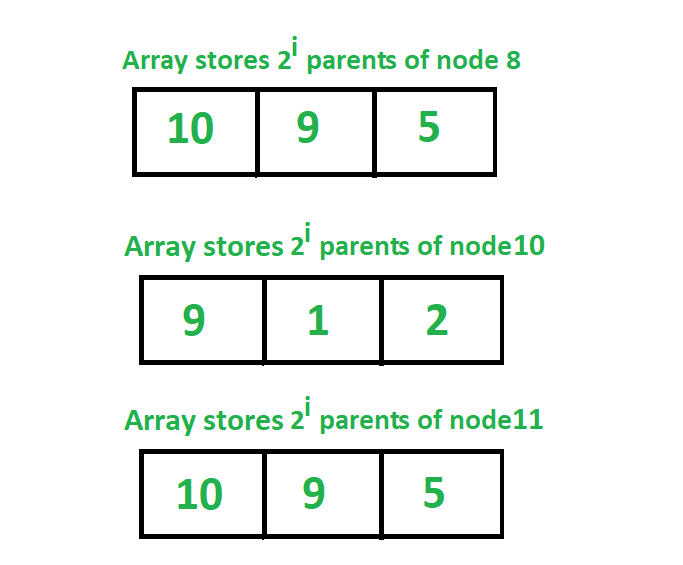本文概述
跳转指针算法是一种针对并行算法的设计技术, 该算法对指针结构(例如数组或链表)进行操作。此算法通常用于确定有根树的森林的根。
在跳转指针算法中, 我们对一棵树进行预处理, 以便人们可以回答查询以找到树中任何节点的任何父节点, 时间复杂度为O(log n).
跳转指针算法将最多log2n个指针关联到树的每个顶点。这些指针被称为跳转指针,因为它们向上跳转到树的根节点。对于处理树的任意节点,算法存储一个长度为l的跳数数组,其中l = log2(depth(v))。这个数组的第i个元素指向节点v的第2个父节点。这个数据结构帮助我们从任何给定的节点跳到树的一半。当要求算法处理查找树中任何节点的父节点的查询时,我们使用这些指针重复地向上跳转树。跳转的次数最多为log n,因此任何查找树中任何节点的父节点的问题都可以在O(log n)时间复杂度内得到回答。
在跳转指针中, 有一个从节点N到N的第j个父节点的指针,
j = 1, 2, 4, 8, …, 依此类推。所以我们存储每个节点的第2^(ith)个父节点。
跳转指针算法基本上适用于以下方法动态编程, 我们使用预先计算的结果来查找下一个结果。通过执行一些简单的计算, 我们可以计算出任何节点的数学公式k, 2Ĵk的父级等于21一2的父母1一k的父级.
该公式的简要说明在下面的算法部分中给出。
该算法最常见的用途是解决需要查找O(log n)时间复杂度的任何节点的祖先的查询。
图来实现跳转指针算法:

存储所有节点的第2个第i个父节点的跳转数组的表示形式:

例子:
Input: 0th parent of node 2
Output: 0th parent of node 2 is = 2
Input: 2th parent of node 4
Output: 2th parent of node 4 is = 2
Input: 3rd parent of node 8
Output: 3rd parent of node 8 is = 1算法:
下面是实现跳转指针算法的算法,以查找图中任何节点的任何父节点。我们用动态规划的方法确定了跳跃矩阵。这里,我们表示根节点为R,并首先假设根节点的父节点为0,这意味着这个节点没有父节点。现在看看图和上面图中显示的数组,我们可以很容易地理解上面的公式来确定每个节点的第2个父节点。如果我们看看8节点值我们可以看到2^0父节点是10,现在找到2^1父节点我们看到2^1父2^0父节点的值是10和2^0的父节点10是8这意味着2^1的父节点2^0 2^0父节点的父节点8 8。同样,我们也可以看到节点8的第22个父节点是5,这是节点8的第2^1个父节点的第21个父节点,即节点的第2^1个父节点,值为9。
因此,通过这种方式,我们可以计算所有存储第2^i个父节点的跳转指针数组。
下面是伪代码, 用于计算存储2的跳转指针矩阵一世树中所有节点的父级。
jump[k][j] = it points 2^jth parent of k
= 2^j-1th parent of (2^j-1th parent of k)
= jump[jump[i][j-1][j-1]实现:以下是实现上述算法的代码, 以查找O(logn)时间复杂度的任何节点的任何父节点。
C ++
//C++ program to implement Jump pointer algorithm
#include <bits/stdc++.h>
using namespace std;
int R = 0;
//n -> it represent total number of nodes
//len -> it is the maximum length of array
//to hold parent of each node.
//In worst case, the highest value of
//parent a node can have is n-1.
//2 ^ len <= n-1
//len = O(log2n)
int getLen( int n)
{
int len = ( int )( log (n) /log (2)) + 1;
return len;
}
//jump represent 2D matrix to hold parent of node in jump matrix
//here we pass reference of 2D matrix so that the change made
//occur directly to the original matrix
//len is same as defined above
//n is total nodes in graph
void set_jump_pointer(vector<vector<int>>& jump, int * node, int len, int n)
{
for ( int j = 1; j <= len; j++)
for ( int i = 0; i <n; i++)
jump[node[i]][j] = jump[jump[node[i]][j - 1]][j - 1];
}
//c -> it represent child
//p -> it represent parent
//i -> it represent node number
//p=0 means the node is root node
//here also we pass reference of 2D matrix
//and depth vector so that the change made
//occur directly to the original matrix and original vector
void constructGraph(vector<vector<int>>& jump, int * node, int * isNode, int c, int p, int i)
{
//enter the node in node array
//it stores all the nodes in the graph
node[i] = c;
//to confirm that no child node have 2 parents
if (isNode == 0) {
isNode = 1;
//make parent of x as y
jump[0] = p;
}
return ;
}
//function to jump to Lth parent of any node
void jumpPointer(vector<vector<int>>& jump, int * isNode, int x, int L)
{
int j = 0, n = x, k = L;
//to check if node is present in graph or not
if (isNode[x] == 0) {
cout <<"Node is not present in graph " <<endl;
return ;
}
//in this loop we decrease the value of L by L/2 and
//increment j by 1 after each iteration, and check for set bit
//if we get set bit then we update x with jth parent of x
//as L becomes less than or equal to zero means
//we have jumped to Lth parent of node x
while (L> 0) {
//to check if last bit is 1 or not
if (L & 1)
x = jump[x][j];
//use of shift operator to make
//L = L/2 after every iteration
L = L>> 1;
j++;
}
cout <<k <<"th parent of node " <<n
<<" is = " <<x <<endl;
return ;
}
//Driver code
int main()
{
//n represent number of nodes
int n = 11;
//initialization of parent matrix
//suppose max range of a node is up to 1000
//if there are 1000 nodes than also
//length of jump matrix will not exceed 10
vector<vector<int>> jump(1000, vector<int>(10));
//node array is used to store all nodes
int * node = new int [1000];
//isNode is an array to check whether
//a node is present in graph or not
int * isNode = new int [1000];
//memset function to initialize isNode array with 0
memset (isNode, 0, 1000 * sizeof ( int ));
//function to calculate len
//len -> it is the maximum length of
//array to hold parent of each node.
int len = getLen(n);
//R stores root node
R = 2;
//construction of graph
//here 0 represent that the node is root node
constructGraph(jump, node, isNode, 2, 0, 0);
constructGraph(jump, node, isNode, 5, 2, 1);
constructGraph(jump, node, isNode, 3, 5, 2);
constructGraph(jump, node, isNode, 4, 5, 3);
constructGraph(jump, node, isNode, 1, 5, 4);
constructGraph(jump, node, isNode, 7, 1, 5);
constructGraph(jump, node, isNode, 9, 1, 6);
constructGraph(jump, node, isNode, 10, 9, 7);
constructGraph(jump, node, isNode, 11, 10, 8);
constructGraph(jump, node, isNode, 6, 10, 9);
constructGraph(jump, node, isNode, 8, 10, 10);
//function to pre compute jump matrix
set_jump_pointer(jump, node, len, n);
//query to jump to parent using jump pointers
//query to jump to 1st parent of node 2
jumpPointer(jump, isNode, 2, 0);
//query to jump to 2nd parent of node 4
jumpPointer(jump, isNode, 4, 2);
//query to jump to 3rd parent of node 8
jumpPointer(jump, isNode, 8, 3);
//query to jump to 5th parent of node 20
jumpPointer(jump, isNode, 20, 5);
return 0;
}Python3
# Python3 program to implement
# Jump pointer algorithm
import math
# Initialization of parent matrix
# suppose max range of a node is
# up to 1000 if there are 1000 nodes
# than also length of jump matrix
# will not exceed 10
jump = [[ 0 for j in range ( 10 )]
for i in range ( 1000 )]
# Node array is used to store all nodes
node = [ 0 for i in range ( 1000 )]
# isNode is an array to check whether
# a node is present in graph or not
isNode = [ 0 for i in range ( 1000 )]
# n -> it represent total number of nodes
# len -> it is the maximum length of array
# to hold parent of each node.
# In worst case, the highest value of
# parent a node can have is n-1.
# 2 ^ len <= n-1
# len = O(log2n)
def getLen(n):
len = int ((math.log(n)) //
(math.log( 2 ))) + 1
return len
# jump represent 2D matrix to hold parent
# of node in jump matrix here we pass
# reference of 2D matrix so that the
# change made occur directly to the
# original matrix len is same as
# defined above n is total nodes
# in graph
def set_jump_pointer( len , n):
global jump, node
for j in range ( 1 , len + 1 ):
for i in range ( 0 , n):
jump[node[i]][j] = jump[jump[node[i]][j - 1 ]][j - 1 ]
# c -> it represent child
# p -> it represent parent
# i -> it represent node number
# p=0 means the node is root node
# here also we pass reference of
# 2D matrix and depth vector so
# that the change made occur
# directly to the original matrix
# and original vector
def constructGraph(c, p, i):
global jump, node, isNode
# Enter the node in node array
# it stores all the nodes in the graph
node[i] = c
# To confirm that no child node
# have 2 parents
if (isNode = = 0 ):
isNode = 1
# Make parent of x as y
jump[ 0 ] = p
return
# function to jump to Lth parent
# of any node
def jumpPointer(x, L):
j = 0
n = x
k = L
global jump, isNode
# To check if node is present in
# graph or not
if (isNode[x] = = 0 ):
print ( "Node is not present in graph " )
return
# In this loop we decrease the value
# of L by L/2 and increment j by 1
# after each iteration, and check
# for set bit if we get set bit
# then we update x with jth parent
# of x as L becomes less than or
# equal to zero means we have
# jumped to Lth parent of node x
while (L> 0 ):
# To check if last bit is 1 or not
if ((L & 1 )! = 0 ):
x = jump[x][j]
# Use of shift operator to make
# L = L/2 after every iteration
L = L>> 1
j + = 1
print ( str (k) + "th parent of node " +
str (n) + " is = " + str (x))
return
# Driver code
if __name__ = = "__main__" :
# n represent number of nodes
n = 11
# Function to calculate len
# len -> it is the maximum length of
# array to hold parent of each node.
len = getLen(n)
# R stores root node
R = 2
# Construction of graph
# here 0 represent that
# the node is root node
constructGraph( 2 , 0 , 0 )
constructGraph( 5 , 2 , 1 )
constructGraph( 3 , 5 , 2 )
constructGraph( 4 , 5 , 3 )
constructGraph( 1 , 5 , 4 )
constructGraph( 7 , 1 , 5 )
constructGraph( 9 , 1 , 6 )
constructGraph( 10 , 9 , 7 )
constructGraph( 11 , 10 , 8 )
constructGraph( 6 , 10 , 9 )
constructGraph( 8 , 10 , 10 )
# Function to pre compute jump matrix
set_jump_pointer( len , n)
# Query to jump to parent using jump pointers
# query to jump to 1st parent of node 2
jumpPointer( 2 , 0 )
# Query to jump to 2nd parent of node 4
jumpPointer( 4 , 2 )
# Query to jump to 3rd parent of node 8
jumpPointer( 8 , 3 )
# Query to jump to 5th parent of node 20
jumpPointer( 20 , 5 )
# This code is contributed by rutvik_56输出如下:
0th parent of node 2 is = 2
2th parent of node 4 is = 2
3th parent of node 8 is = 1
Node is not present in graph
![从字法上最小长度N的排列,使得对于正好为K个索引,a[i] a[i]+1](https://www.lsbin.com/wp-content/themes/begin%20lts/img/loading.png)